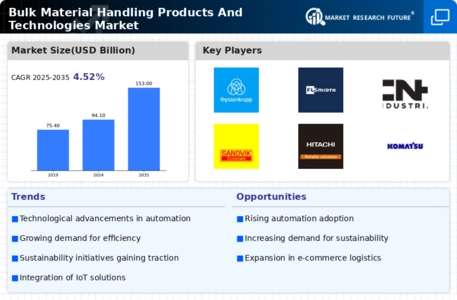Focus on Sustainability
Sustainability is becoming a central theme in the Global Bulk Material Handling Products And Technologies Market Industry, as companies strive to reduce their environmental impact. The adoption of eco-friendly materials and energy-efficient equipment is gaining traction, driven by regulatory pressures and consumer demand for sustainable practices. Companies are investing in technologies that minimize waste and enhance recycling processes, which not only benefits the environment but also improves operational efficiency. This focus on sustainability is likely to influence purchasing decisions and drive market growth as organizations seek to align with global sustainability goals.
Increasing Urbanization
Urbanization is a significant driver of the Global Bulk Material Handling Products And Technologies Market Industry, as it leads to heightened demand for construction materials and infrastructure development. As urban areas expand, the need for efficient material handling solutions becomes critical to support construction activities. This trend is particularly pronounced in developing countries, where rapid urban growth necessitates the use of advanced bulk handling technologies. The market is expected to grow substantially, reaching 153.0 USD Billion by 2035, driven by the increasing need for effective material management in urban construction projects.
Market Growth Projections
The Global Bulk Material Handling Products And Technologies Market Industry is projected to experience substantial growth over the coming years. With an estimated market value of 94.1 USD Billion in 2024, the industry is expected to expand significantly, reaching 153.0 USD Billion by 2035. This growth trajectory suggests a compound annual growth rate (CAGR) of 4.52% from 2025 to 2035, indicating a robust demand for bulk handling solutions. The increasing complexity of supply chains and the need for efficient material management are likely to drive this growth, as businesses seek to enhance their operational capabilities.
Technological Advancements
The Global Bulk Material Handling Products And Technologies Market Industry is experiencing a surge in technological advancements, which enhances efficiency and safety in operations. Innovations such as automated guided vehicles (AGVs) and smart conveyor systems are becoming increasingly prevalent. For instance, the integration of IoT in material handling equipment allows for real-time monitoring and predictive maintenance, reducing downtime. This trend is expected to drive the market's growth as companies seek to optimize their supply chains. As a result, the market is projected to reach 94.1 USD Billion in 2024, reflecting the industry's commitment to adopting cutting-edge technologies.
Rising Demand for Automation
The Global Bulk Material Handling Products And Technologies Market Industry is witnessing a rising demand for automation across various sectors, including manufacturing, mining, and logistics. Automation not only improves operational efficiency but also minimizes human error and enhances safety. Companies are increasingly investing in automated systems to streamline their processes, which is likely to contribute to market growth. The anticipated compound annual growth rate (CAGR) of 4.52% from 2025 to 2035 indicates a robust shift towards automated solutions. This trend is particularly evident in industries that handle large volumes of bulk materials, where efficiency is paramount.
Global Supply Chain Optimization
The optimization of global supply chains is a crucial driver for the Global Bulk Material Handling Products And Technologies Market Industry. As businesses expand their operations internationally, the need for efficient bulk material handling solutions becomes increasingly important. Companies are looking to streamline their supply chains to reduce costs and improve delivery times. This trend is reflected in the growing investment in advanced material handling technologies that facilitate better inventory management and logistics. The market's growth is indicative of this shift, as organizations prioritize efficiency in their supply chain operations.





















Leave a Comment